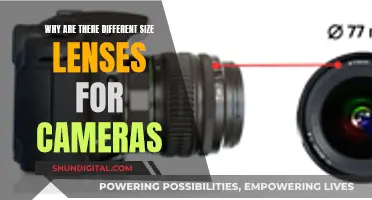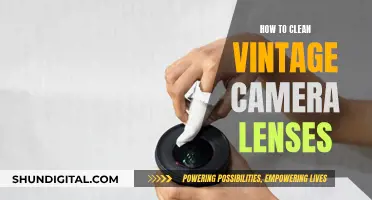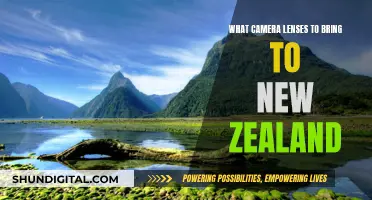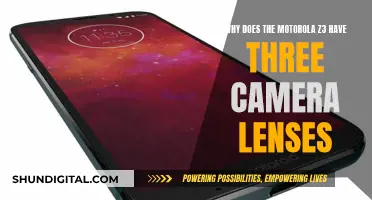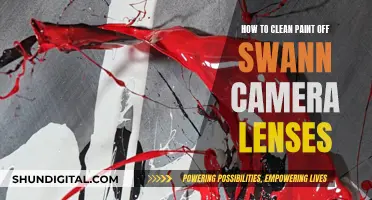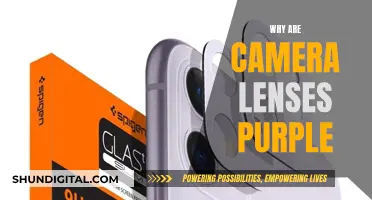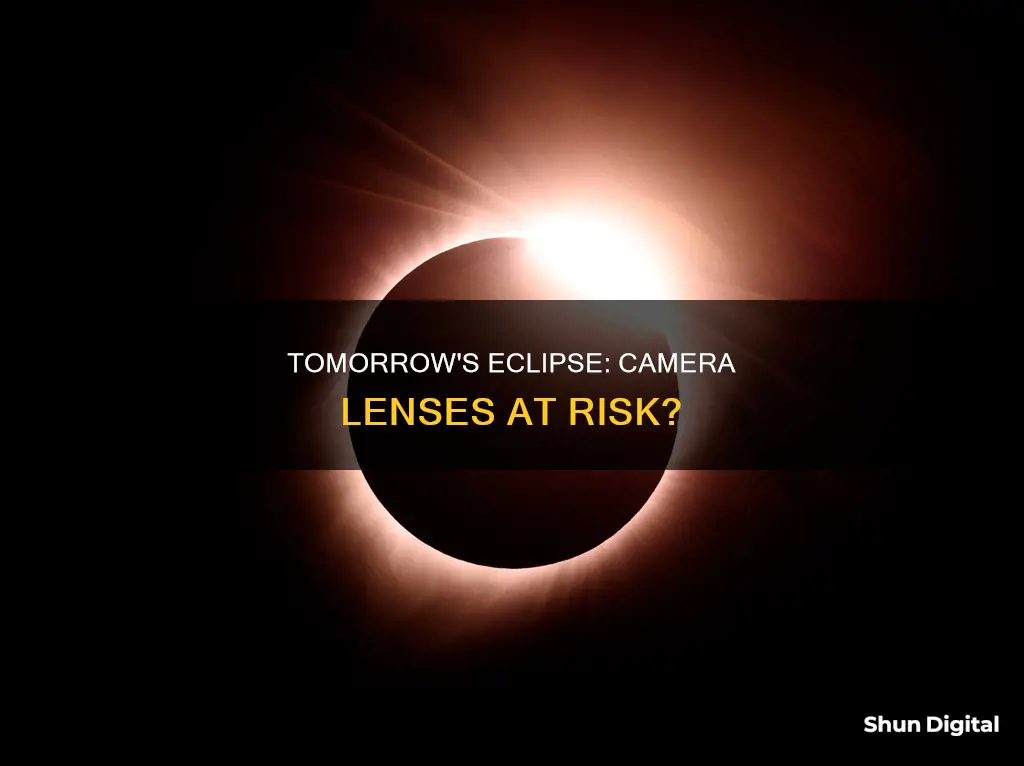
Tomorrow's solar eclipse is a highly anticipated event, and many will be keen to capture the phenomenon on camera. However, it is important to be aware that pointing a camera directly at the sun can cause damage to the camera's lens, sensor, and other internal components. The sun's rays can overwhelm the camera's sensors, and the intense, focused light can damage internal elements such as the aperture blades and shutter. This is true for both digital and film cameras, as well as smartphones. To safely photograph the eclipse, it is recommended to use a solar filter over the camera lens. These filters block ultraviolet and infrared radiation, protecting your equipment from the sun's harmful rays.
| Characteristics | Values |
|---|---|
| Camera lenses safe to use during eclipse | Specialised solar filters are required to protect the camera lens from damage. |
| Safe to look at the eclipse through a camera | Looking at the eclipse through a camera without a solar filter is unsafe and can cause severe eye damage. |
| Safe equipment | Cameras, telescopes, and binoculars require a solar filter. Eclipse glasses are safe to use for direct viewing. |
| When is it safe to remove filters | During totality, when the moon fully blocks the sun, it is safe to briefly remove filters. |
What You'll Learn
- The sun's rays can damage your camera's sensor
- Special solar filters are needed for cameras and smartphones
- Looking at the sun through a camera viewfinder can damage your eyes
- Smartphone cameras are not equipped to take photos of the sun
- Photographing the eclipse with a smartphone will likely result in overexposed photos

The sun's rays can damage your camera's sensor
The sun's rays can indeed damage your camera's sensor, and you should take precautions to avoid this. The sensor in your camera is made of photosensitive material, so when light hits it, an electric charge is produced. The higher the intensity of light, the higher the electric charge generated. Therefore, exposing the sensor to a source of light that is too bright can cause damage.
The sun is the brightest natural source of light available, and even a brief exposure can be enough to damage the sensor. The damage will occur due to the excessive amount of light entering the sensor. The sun's rays can also damage your camera's shutter curtains, aperture diaphragm, and AF sensors.
To put this into perspective, consider the following: an adult human iris has an approximate diameter of 13mm. An 85mm lens at F/1.8 would have an approximate aperture diameter of 47mm. That is approximately 3.5 times the diameter and almost 12 times the size. If the sun is too bright to look at with the naked eye, the amount of light entering your camera, even at fast shutter speeds, may be enough to cause damage.
You can further understand the risks by considering the following scenarios:
- Shooting the sun during dawn or dusk—OK
- Shooting the sun at noon during a cloudy sky—OK
- Shooting the sun at noon with a clear sky—Be Careful
- Shooting portraits, street, architecture, or landscape at noon with a clear sky—OK, as long as you're careful about how long and how often your camera points directly at the sun
In addition to the sun, other intense sources of light can also damage your camera's sensor. For example, concert lights, also called laser lights, can be found at discos, weddings, concerts, and music festivals. While these lights won't annihilate your sensor like the sun, they will kill the pixels that they come in contact with.
To protect your camera's sensor from damage, you can use ND (Neutral Density) filters, which are essentially sunglasses for your camera. These filters attach to the front of the lens and help block a specific amount of light that enters. You can also use a solar filter, which blocks over 99% of light and heat and is designed primarily for telescopes, but now they are also available for modern digital cameras.
It is important to note that even if you take precautions to avoid sensor damage, you can still cause significant damage to your camera due to the heat generated by the sun. This heat can damage your camera's internals, including the sensor, shutter, and diaphragm.
Lastly, remember that your eyes are also at risk when shooting directly into the sun. A camera lens can focus sunlight onto your eyes, similar to a magnifying glass, and cause severe damage in seconds. Therefore, it is crucial to use proper eye protection, such as eclipse glasses, when shooting in the direction of the sun.
Samsung Galaxy S10: The Power of Triple Camera Lens
You may want to see also

Special solar filters are needed for cameras and smartphones
Solar eclipses are undoubtedly awe-inspiring events, and it's only natural to want to capture them on camera. However, pointing your camera or smartphone directly at the sun during an eclipse can cause damage to your device. The intense light and heat from the sun's rays can overwhelm the sensors in your sensitive photo equipment, leading to potential damage. This applies to all types of cameras, including digital cameras, DSLRs, mirrorless cameras, and even smartphones.
To protect your camera or smartphone during an eclipse, it is essential to use a special solar filter. These filters are designed to reduce the amount of sunlight and heat that reaches the camera's sensor, preventing potential damage. Solar filters for cameras and smartphones are readily available and can be purchased from major national retailers or specialist suppliers. They are relatively inexpensive, with some options costing less than $10.
When choosing a solar filter, it is important to ensure that it is specifically designed for your device and that it meets the international safety standard, ISO 12312-2. This standard ensures that the filter will reduce visible sunlight to safe levels while also blocking solar UV and IR radiation. It is crucial that the filter is securely attached to the front of your camera lens or smartphone camera, providing effective protection without obstructing your view.
In addition to using a solar filter, there are a few other tips to keep in mind when photographing a solar eclipse. Firstly, during the totality phase, when the moon completely blocks the sun, you can briefly remove the filter to capture the sun's outer atmosphere, known as the corona. However, it is important to be quick to replace the filter as soon as totality ends. Secondly, consider practising by taking pictures of the moon to familiarise yourself with the settings and conditions. Using a zoom lens, a remote shutter, and a delay timer can also enhance your photographs.
By following these guidelines and using the appropriate solar filters, you can safely capture breathtaking images of a solar eclipse without risking damage to your camera or smartphone. Remember, it is crucial to prioritise the protection of your equipment and your eyes during this extraordinary celestial event.
APS-C Lenses: Universal Fit for All Cameras?
You may want to see also

Looking at the sun through a camera viewfinder can damage your eyes
Looking directly at the sun can cause permanent damage to your eyes, and looking at the sun through a camera viewfinder is no exception. In fact, it can be even more dangerous due to the focusing effect of the camera lens.
The sun emits high levels of ultraviolet (UV) and infrared radiation, as well as visible light. When these rays pass through a camera lens, they are concentrated, intensifying their effect. This focused light can burn your eye and cause permanent damage to your retina, even if you only look for a short time.
Even if you don't feel any discomfort or pain when looking at the sun through a camera viewfinder, that doesn't mean your eyes are safe. The sun's rays can damage your eyes without you realising it, and the effects may not be apparent until hours later. By then, it's too late to do anything about it, and the damage to your vision could be irreversible.
To protect your eyes, never look at the sun through a camera viewfinder without proper eye protection, such as eclipse glasses or a solar filter over the camera lens. Keep in mind that regular filters like UV or neutral density (ND) filters are not sufficient to protect your eyes from the sun's rays. Only use solar filters designed specifically for viewing the sun.
Additionally, be cautious when using digital cameras with electronic viewfinders or screens. While these may be safer than optical viewfinders, it's still best to avoid prolonged exposure to the sun's rays, as the sensors and screens can also be damaged by intense light.
In summary, looking at the sun through a camera viewfinder can be extremely harmful to your eyes. Always use proper eye protection and take the necessary precautions to safeguard your vision when photographing the sun or an eclipse. Your eyesight is precious, so don't take any risks.
Camera Lenses: Is Price Tag Directly Linked to Quality?
You may want to see also

Smartphone cameras are not equipped to take photos of the sun
While it may be tempting to capture the upcoming total solar eclipse on your phone, photography experts advise against pointing your smartphone directly at the sun. The sun's intense rays can damage not only your eyes but also your phone's camera sensor. This is due to the concentration of light by the camera lens, which acts like a magnifying glass.
Smartphone cameras lack the necessary protective filters for safe solar photography. The standard lenses on smartphones are very small and do not have the resolution required for capturing large objects in the sky, like the sun and moon. As a result, attempting to photograph the sun with a smartphone will likely result in overexposed and inferior images.
To safely photograph the sun or a solar eclipse, it is recommended to use solar filters designed for smartphones or digital cameras. These filters reduce the visible sunlight entering the camera to a safe level and block harmful ultraviolet and infrared radiation. Additionally, during the brief period of totality, when the sun is completely obstructed, it is possible to take unfiltered photographs with a smartphone, but only for a fleeting moment.
It is important to prioritize safety when attempting to capture images of the sun or a solar eclipse. Always use the appropriate protective equipment and follow expert guidelines to avoid damaging your eyes and your smartphone camera.
Q-See Camera Lenses: Plastic or Glass?
You may want to see also

Photographing the eclipse with a smartphone will likely result in overexposed photos
Photographing an eclipse is a challenging task, and doing so with a smartphone will likely result in overexposed photos.
Smartphone cameras have small sensors and lenses, which makes it difficult to capture detailed images of the eclipse. The eclipse is a "small and dazzling" object, and as such, it is challenging to photograph. Smartphone cameras were never designed to take images of the sun and moon, so it is not surprising that they struggle to produce good photos of an eclipse.
The eclipse will likely appear as a bright white blob in your photos, and you will struggle to make out any details. This is because smartphone cameras lack the resolution needed for large objects in the sky, like the sun and moon. The eclipse will overwhelm the sensors in your phone, resulting in overexposed photos.
To avoid overexposed photos, you can use a solar filter over your phone's lens. These filters are relatively inexpensive and can be found at major national retailers for under $10. Alternatively, you can hold a pair of ISO-certified eclipse glasses over your phone's lens when taking photos.
It is important to note that pointing your smartphone directly at the sun may cause damage to your device, and it is essential to protect your eyes when viewing or photographing the eclipse.
Radioactive Camera Lenses: Are They Safe to Use?
You may want to see also
Frequently asked questions
Yes, but you will need a solar filter to protect your phone's lens. These can be purchased inexpensively at major national retailers.
You will need a solar filter that fits over your camera lens. ND and polarising filters will not work.
The eclipse can damage your camera's lens, sensor, shutter, mirror, and internal elements.
You can only remove the filter during totality when the moon is fully covering the sun.


